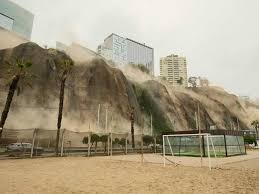Earthquake off Peru’s coast shakes capital Lima; 1 person dead, 5 injured

Lima, Peru — June 15, 2025:
A powerful earthquake struck off the coast of Peru on Sunday, sending tremors through the capital city of Lima and surrounding regions. The quake caused significant alarm among residents, led to the death of one person, injured five others, and disrupted daily life across the metropolitan area.
According to preliminary data from Peru’s Geophysical Institute (IGP), the earthquake registered a magnitude of 5.6 on the Richter scale, though some international seismic agencies initially reported it as a 6.1 magnitude event. The epicenter was located about 23 kilometers southwest of Callao, a vital port city adjacent to Lima, at a depth of around 35 kilometers.
A Sudden Jolt
The earthquake struck at approximately 11:35 a.m. local time, catching many residents off guard during a typically busy Sunday morning. Within seconds, buildings swayed, vehicles came to sudden halts, and people poured into the streets seeking safety.
In downtown Lima, shoppers and pedestrians fled stores, cafes, and religious services. A Catholic Mass at the historic Lima Cathedral was abruptly paused as chandeliers swung and parishioners rushed outside in fear. Similarly, fans attending a football match at the Alberto Gallardo Stadium were seen scrambling from the stands amid the shaking.
Human Toll and Structural Damage
Authorities confirmed that one person lost his life as a result of the quake. The victim, a 36-year-old man, was fatally struck by debris from a partially constructed building in northern Lima. Eyewitnesses reported that part of a concrete wall on the fourth floor collapsed during the tremor, sending rubble cascading onto the sidewalk below.
In addition to the fatality, five individuals sustained injuries, primarily from falling objects and broken glass. Emergency services transported the injured to nearby hospitals. Though none of the injuries were initially reported as life-threatening, local health officials are closely monitoring the victims.
While Lima avoided widespread destruction, several neighborhoods reported minor to moderate structural damage. Cracks appeared in walls and facades, billboards were dislodged, and some roads in coastal districts showed signs of subsidence. Reports from Callao indicated that several schools and residential buildings sustained superficial damage, prompting precautionary inspections.
President Boluarte Responds
Peru’s President, Dina Boluarte, visited the impacted areas in Callao shortly after the quake. She expressed condolences to the victim’s family and emphasized the government’s commitment to assessing and addressing damage swiftly.
“We are coordinating with regional authorities and the Civil Defense to ensure safety protocols are followed, and that affected families receive immediate support,” President Boluarte said during a press briefing.
She also urged citizens to remain calm and follow official guidelines in the event of aftershocks.
Seismic Reality of Peru
Peru lies along the Pacific Ring of Fire, a seismically active zone notorious for frequent earthquakes and volcanic eruptions. The region’s tectonic activity is driven by the subduction of the Nazca Plate beneath the South American Plate, which causes stress accumulation and sudden seismic releases.
Historically, Peru has experienced several devastating earthquakes. The most catastrophic in recent memory was the 2007 Pisco earthquake, which left over 500 dead and thousands injured. Though Sunday’s quake was significantly less destructive, it served as a stark reminder of the country’s ongoing vulnerability to natural disasters.
Emergency Preparedness and Citizen Response
Following the tremor, Peru’s Instituto Nacional de Defensa Civil (INDECI) activated its emergency response plan. Mobile alerts were sent across the country, and local authorities began surveying buildings for safety compliance. Public schools and government offices in Lima were temporarily closed for inspections.
Citizens took to social media to share videos and photos of the quake’s effects—swinging lamps, cracked walls, and people gathering in open spaces. Hashtags like #TemblorPeru and #SismoLima quickly began trending on platforms like X (formerly Twitter) and Instagram.
Despite moments of panic, there were also displays of community solidarity. In several districts, neighbors helped evacuate older people, assist those with mobility challenges, and offer emotional support to shaken families.
Disruptions and Recovery
Public transportation services, including Lima’s Metropolitano bus system, temporarily paused operations to conduct safety checks. Flights at Jorge Chávez International Airport in Callao were briefly suspended, though no major damage was reported at the facility.
Utilities in most areas—including electricity, water, and internet—remained largely functional. However, intermittent outages occurred in some neighborhoods closer to the epicenter, including La Punta and Ventanilla.
By late afternoon, authorities confirmed that most services had resumed and no tsunami warning had been issued. The IGP stated that while aftershocks could occur in the coming days, they were expected to be minor.
A Reminder to Stay Vigilant
As Peru resumes normalcy following Sunday’s jolt, experts and government officials continue to stress the importance of earthquake preparedness. The country has made strides in implementing building codes and public awareness campaigns, yet densely populated urban areas like Lima remain at risk due to informal construction and limited emergency infrastructure.
Residents are encouraged to keep emergency kits, know evacuation routes, and participate in community drills.






